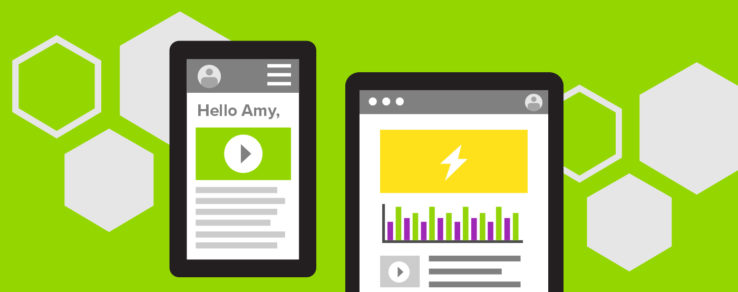Today’s customers expect more than just a reliable energy supply from their utility. They want to take control of their energy use — to save money, or reduce their carbon footprint, or just make their homes more comfortable — and they’re looking for advice and resources that will help.
Energy providers can give customers that support by taking advantage of utility personalized communications. By leveraging their data to understand customers’ needs and preferences, and delivering messages tailored to each individual, utilities can better connect customers with relevant, useful resources.
“Customers expect marketing messages to be relevant to their needs and interests — or they will simply tune them out,” says Jared Brandon, Director of Innovation at Harris Computer. “Utilities need to be communicating in the same way.”
Utilities can learn from outside industries like retail, tech and consumer goods on how to tailor messages to individual customers. With personalized energy communications, utilities can build the same kinds of digital relationships that customers expect from other popular brands.
For example, Starbucks takes advantage of personalization through its gamified mobile app. The app uses customer data like purchase history, mobile app usage and location to recommend products, build loyalty and increase engagement.
Shutterfly, a website for creating personalized cards, photo books and gifts, uses personalization in its marketing efforts. When customers download the company’s app, they can allow Shutterfly to access their photos. With this feature, each product is personalized with the customer’s photos, encouraging them to make a purchase.
As these examples illustrate, personalization is everywhere in today’s digital landscape. Utilities can adopt a similar approach when communicating with their customers.
Personalized Communications: The Utility Advantage
Customers view their utility as an energy expert and helpful resource, whether they need advice on improving home energy efficiency or taking advantage of solar power. Personalized energy communications allow utilities to give customers the detailed and accurate energy information they expect — and which they can’t get from any other source. This is a powerful differentiator for utilities.
“Utilities have information that people care about,” says Matt Irving, Questline Digital’s Creative Director of Video. “I think it’s valuable for customers to know, for example, where they fall in terms of energy efficiency compared to their neighbors. Utilities have all this data at their disposal. Why not use it to make personalized videos to improve the customer experience?”
Data is an important component of a personalization strategy, used to create customer segments and identify characteristics for targeted messages. But data can also be used in the content of the messages themselves. Customers can learn how their energy usage compares to their neighbors, for example, or how a new rate plan would affect their bill based on their actual energy usage.
“You could send them a positive message like, ‘Great job for reducing your energy usage! That’s comparable to a reduction of (insert number) gasoline-powered cars on the road,’” Irving says. “Positive feedback just makes customers feel good and encourages them to keep pushing forward to reduce their energy usage even more.”
One of the biggest benefits of utility personalized communications is educating customers on complex energy programs and technologies, like time-of-use rate plans (TOU) and smart meters. For example, a TOU marketing message is much more effective when it provides specific information on how much a customer can save based on their energy usage behaviors. Without personalization, the savings benefit is ambiguous.
“The reality is that customers don’t live and breathe the utility industry,” Brandon says. “Personalization can simplify complex industry-specific topics to a layman’s audience, while also showing customers why a particular program is relevant to them.”
A Midwest-based utility recently used personalized videos to educate customers about relevant financial assistance programs and encourage enrollment. The videos provide each recipient with tailored program recommendations based on their energy usage, past program participation and payment history. The videos have voiceovers and onscreen graphics that are unique to each customer.
In a Questline Digital webinar, Tony Todesco, Market Research Senior Specialist with Con Edison, explained that personalization was essential to prepare for community events.
The utility’s outreach team leveraged zip code-level statistics to prepare for these events held in local neighborhoods throughout New York City and Westchester County. They gained important information like language preferences, education, affinity for tech adoption, likelihood of being eco-friendly and more.
“In marketing, we’re primarily using this data to analyze key customer segments, like electric vehicle drivers, solar adopters and low-income customers, and use the findings to refine our marketing strategy and act on opportunities,” Todesco says. “This data typically takes the form of personas characterizing specific users of technology. We always learn something new with personas.”
Effective Communications Require the Right Data
Utilities have a wealth of customer data available to them for personalized energy communications, including energy usage, program participation, content consumption and more.
According to a recent survey, the biggest challenge for utilities is finding the right tools to gather and analyze customer data. While this is a vital step to ensure accuracy, McKinsey & Company notes that utilities shouldn’t be hung up on how much data they have. To send effective personalized energy communications, utilities don’t need more customer data – they simply need the right data.
To truly connect with customers and provide value, personalization is only going to grow in importance. As utilities ramp up their efforts to communicate with customers about complex topics, like TOU, smart meters and demand response, utility personalized communications will be necessary to educate, engage and encourage program participation.
“If you want customers to stay engaged to receive the full message, and actually take meaningful actions from it, communications have to be personalized,” Brandon says. “Greeting customers by name, showing them their usage, and how a program specifically impacts them helps to build trust and deliver value.”

